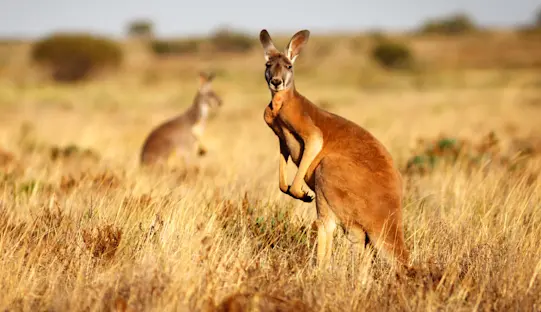
There are almost 30 species of goannas in Australia. It’s theorized that they proliferated because when they arrived on the continent, there were relatively few medium-sized carnivores competing for the same resources.
Teaching was once considered a uniquely human behavior. Today, however, scientists recognize a small but diverse group of species who have the ability to act as instructors.
Usually, however, when we call a nonhuman animal a “teacher,” we mean that an adult animal shows its own young how a certain behavior will lead to a desired objective. What’s far more intriguing, I think, is when animals demonstrate how adept they are at teaching others from species different than their own. For example, in Australia young cane toads—an invasive species—are teaching native goannas, a predatory lizard, to avoid eating adult cane toads, a far more deadly prospect than consuming young ones.
Cats, corvids and rats are also taking on the role of educators—to us. Researchers now consider the evolution of how we build bird feeders to be an example of a multispecies design, where unwanted “guests” have trained us how to shape one of our own artifacts.

Native to Central and South America, cane toads were released in the northern state of Queensland, Australia, in 1935 to eat cane beetles. They are now considered invasive pests. When threatened, cane toads excrete a milky venom from enlarged glands on their shoulders, which acts on the heart causing cardiac arrest in most animals.
Toad teachers
According to the Australian Museum, goannas—or monitors, as they are known elsewhere in the world—are a very distinctive group of lizards. They evolved in the Northern Hemisphere in the Upper Cretaceous Period about 90 million years ago. However, in the Miocene Epoch, about 15 million years ago, goannas moved south into Africa and Australia. In Africa, only a few species developed; but in Australia, goannas grew into roughly 28 species, at least one of which is extinct (Varanus priscus, a giant goanna that could be almost 20 feet in length).
Most goannas are carnivores. They find their food by searching widely across the landscape, catching animals by stalking or digging them out of nests and shelters. They are aided in their search for food by their long, forked tongues, which they flick in and out, picking up chemicals in the air and on the ground. Goannas then “read” these chemicals with a special organ in the roof of the mouth.
One of the most distinguishing features of the evolution of goannas in Australia is that their size range is enormous, but their body shape has changed very little over time. The scarcity of competitors in Australia provided goannas with an evolutionary opportunity: stick with one way of making a living and apply it over a spectrum of body sizes.

The stunning and sparsely settled Kimberley in Western Australia’s northern region is known for large swaths of wilderness defined by dramatic gorges, rugged ranges, semiarid savannas and a largely isolated coastline.
Unfortunately for the native goannas, however, invasive cane toads crossed into Western Australia in 2009 and have worked their way across the Kimberley, with disastrous results. When apex predators like goannas eat an adult cane toad, they die quickly but painfully.
Cane toads were introduced to Australian sugarcane farms in 1935 to control pests. Since then, they’ve spread across the tropics, decimating populations of native Australian predators who eat them, sending ripples through whole ecosystems from the top down. Free from large predators, lizards and snakes breed in huge numbers, exerting strong pressure on their prey species, such as frogs and smaller lizards, who then decline. This can cause insect species to proliferate, annihilating many plant species. So far, the spread of cane toads has been unstoppable.
Now, however, scientists are experimenting with employing “taster toads” to teach the goannas not to eat adult cane toads. This clever strategy—pioneered by researchers at Macquarie University in Sydney, Australia—has been outlined in the science journal Conservation Letters.

The Fitzroy Valley is 1,553 miles north of Perth in the remote Kimberley region of Western Australia. The valley is home to approximately 4,500 people, 80% of whom are Aboriginal, belonging to five language groups (Bunuba, Gooniyandi, Nyikina and Walmajarri/Wangkatjungka). There are 45 distinct communities, ranging from 300 people in the town of Fitzroy Crossing to small cattle stations with as few as 10 to 20 people.
Back in 2016, the scientists ran small-scale field trials, which showed that when goannas are first exposed to younger, smaller cane toads, they get sick from eating them, but they don’t die. Most will then avoid eating another cane toad and survive. That’s a form of what scientists call “ecological immunization,” or building resilience in native wildlife against invasive species.
Initially, the research team taste-trained (called “conditioned taste aversion”) individual goannas in the field, tracking them with radio tags during the arrival of the highly poisonous, adult cane toads heading the invasion front line. The taste-trained goannas had far better survival rates. At control sites which did not introduce the small, taster toads before the more deadly adult cane toads arrived, goanna populations plummeted by up to 94%. However, at sites where taste aversion was trialed, goanna populations ranged from 35% to 140% of preinvasion levels by the time the study finished.
This study tracks Australia’s largest cane toad mitigation strategy to date. Upscaling the methodology from individual trials to the ecosystem level was an exercise in collaborative partnerships and logistics. Thousands of eggs, tadpoles and juvenile cane toads were released into wild water bodies in the Fitzroy Valley in Western Australia’s Kimberley region, immediately ahead of the invasion front line. Camera traps and sardine-tin baits were used to observe the goanna populations.

Goannas mostly live on the ground and dig holes for burrows to protect eggs from predators and to provide a constant temperature for embryo development.
The scientists say that although their intervention was targeted to relatively small, specific populations in Western Australia, its results will have long-term impacts. By managing the initial effects of the cane toad invasion, goanna populations will continue to survive because after the invading cane toads begin breeding, plenty of baby toads will “train” the next generation of goannas, without people having to keep adding more toads to the system. Behavioral interventions, say the researchers, can be a viable alternative to traditional wildlife management approaches that try to wipe out invasive species—a goal that is often impossible to achieve.
And while it may not be feasible to deploy “teacher toads” across the whole Australian tropics as of now, at least pockets with healthy predator populations can be maintained. Potentially, this method could be used to repopulate areas where goannas have become locally extinct. Even a single deployment can have long-term effects, conclude the researchers.
That’s good news for Traditional Owners (descendants of the ethnic group or tribe that occupied a particular region before European settlement) across Western Australia, since goannas are significant cultural totems and an important bush tucker food (any food native to Australia and historically eaten by Indigenous Australians, or any native fauna, flora or fungi used for culinary or medicinal purposes). For example, in parts of the Kimberley, there can be five different words associated with a goanna burrow—whether it’s a nesting burrow, a nighttime burrow, etc.—so if goannas should disappear from the landscape, those aspects of the culture would be lost, too.

Over the years, bird-feeder design has evolved. At the turn of the 20th century, a roof was placed on top of the feeding board—predominantly to keep rainwater and snow away from the food—a characteristic that continues to today.
Pest professors
Bird-feeding is a common and dear hobby in many Western countries and has been studied extensively. Nevertheless, bird feeders have not received much attention. Now, after investigating the rapid evolution of bird-feeder design starting in the 19th century and going through the 20th, researchers at Aalto University and the University of Helsinki in Finland say the feeders are an example of a multispecies design, where unwanted visitors have shaped a human-made artifact.
Earlier research had shown that the users of artifacts and technology shape their design. Using descriptions of bird feeders and guidelines for bird-feeding issued in Finnish magazines and newspapers from the end of the 19th century until the end of the 20th century, the Finnish researchers combined approaches from design studies, environmental history, environmental humanities, and studies of science and technology to uncover the role of species other than humans in the evolution of technological artifacts; in this case, bird feeders.
In a paper published in the science journal Environment and Planning E: Nature and Space in April 2024, the researchers argue that a bird feeder is not essential for feeding birds, as food can simply be thrown on the ground. Bird feeders were designed to keep unwanted guests, such as corvids, rats or salmonella away, so that small-sized birds can obtain more food and are kept safe. They noted four major changes in bird-feeder design: 1) at the turn of the 20th century, a roof was placed on top of the feeding board to keep snow and rainwater away from the food; 2) from the 1910s onward, it was suggested that bird feeders either be hung or placed on top of a long stick to prevent cats and rats from reaching the bird food; 3) in the 1930s, it was recommended that bird feeder slits for seeds be kept small to prevent large birds from accessing the food; and 4) during the final phase, from the 1970s on, salmonella and other pathogens began worrying people, so bird-feeder design began prioritizing easy cleaning and keeping feces away from the feeder. Automated feeders became much more common.

Placing a bird feeder on top of a long stick or pole became popular around 1910. The purpose was to prevent cats or rats from reaching the food inside.
This research suggests that the reason for these design choices was more concerned with excluding species from the feeder rather than feeding birds. It’s a story of reciprocal actions, where humans want to prevent a species, such as rats, from accessing bird feeders by modifying the structure, after which the rats test whether the modification was successful.
What’s written about bird-feeder designs also tells us a great deal about the changing attitudes towards species in our own backyards, especially when those species are perceived to be problematic. While a great deal is written about welcome guests, such as various endangered species, unwanted guests elicit equally passionate discourses. One example of that is salmonella, which has led people who use the “wrong” type of old-fashioned bird feeders to be branded as the worst threat to small-sized birds.
The paper’s authors say they will continue their studies by analyzing the photos and stories regarding bird feeders that were obtained from Finnish bird-feeding enthusiasts during the winter of 2022 to 2023.

Goannas feature prominently in Aboriginal mythology and Australian folklore. In earlier times, people recognized and respected animals as intelligent kin. Perhaps we should once again pay attention to what the more-than-humans can teach us.
Feral familiars
In her 1996 book Animals as Teachers and Healers, author Susan Chernak McElroy writes: “In their innocence and wisdom, in their connection to the Earth and its most ancient rhythms, animals show us a way back to a home they have never left.” So, could there be any better candidates for teaching us and the others who share our planet about the world and its ways?
In earlier times, people recognized and respected animals as kin. Because of that bond, animals were often considered to be our familiars, healers and guides long before they were ever domesticated.
I see no reason why now—especially when we need all the best minds working together to help solve our ecological and environmental challenges—we shouldn’t pay attention to what other animals can teach us.
Here’s to finding your true places and natural habitats,
Candy


































